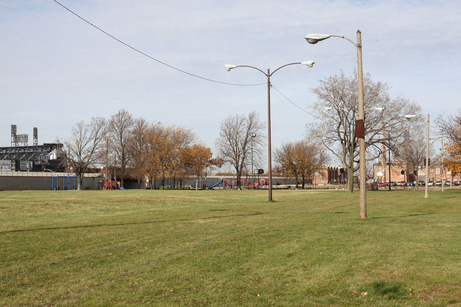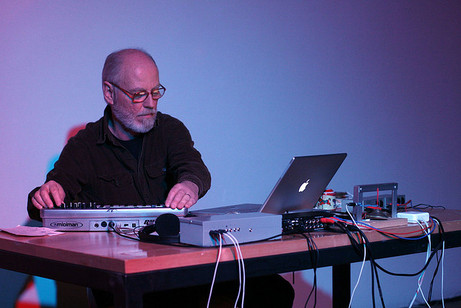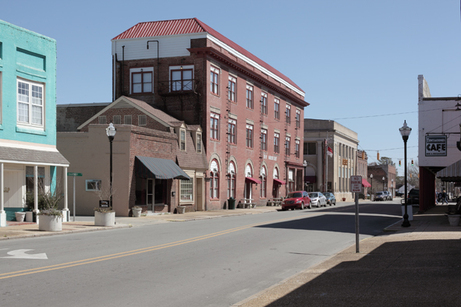From top, left to right: Ronald Shiffman, Henry Sanoff, Graham Adams, David Perkes, Michael Rios, Roberta Feldman, Catherine Baker / Peter Landon / Jeff Bone.
Screening: Where If Not Us? Participatory Design and Its Radical Approaches
Jul 24, 2013
(6pm)
Please RSVP
Please join us for a dedicated screening of Where If Not Us? Participatory Design and Its Radical Approaches. This 100 minute video piece, made for our current exhibition, showcases selections from in depth interviews with each individual and group included in architect Mathias Heyden and artist Ines Schaber’s multi-stage research project about the development and future of participatory design in the United States. Offering an investigation of each protagonist’s position on questions about radicality in the field of community design, the film is comprised of conversations with Henry Sanoff, Graham Adams, David Perkes, Michael Rios, Roberta Feldman, Landon Bone Baker Architects, Ron Shiffman and Roger Borgenicht, Brandy Brooks, Monica Chadha, Kathy Dorgan, Daniel J. Glenn, Sharon Haar, Shally W. Harrison, Jeffrey Hou, and Alan J. Plattus.


Mathias Heyden and Ines Schaber, Wentworth Gardens, Chicago, Illinois, USA, 2011, revisited with Roberta Feldman. (A demolished public housing site at State Street remains in front of new affordable housing and the Chicago White Sox stadium.)
Public Discussion: Participatory Design and Its Radical Approaches
Jun 28, 2013
(6pm)
Please RSVP
Please join us for a public discussion with architect Mathias Heyden and artist Ines Schaber about their Graham-funded research and exhibition Where If Not Us? Participatory Design and Its Radical Approaches. Brief presentations by exhibition participants Roberta Feldman, Landon Bone Baker Architects, and Henry Sanoff will be followed by an open discussion about the past, present, and future of participatory design in Chicago and beyond.
Mathias Heyden is a Berlin-based architect, activist, organizer, author, curator, and co-founder of community project K 77. Currently he is an assistant professor and chair of Urban Design and Architecture at the Institute of Architecture, Technical University Berlin. Heyden is the author of numerous publications including Under Construction, Strategies of Participatory Architecture and Spatial Appropriation (with Jesko Fezer, 2003 - 2007) and the exhibition and magazines An Architecture 19-21: Community Design. Involvement and Architecture in the US since 1963 (with An Architektur, 2008).
Ines Schaber is an artist, photographer, and author living in Berlin, Germany. She studied fine art at the Academy in Berlin, architectural theory at Princeton University, and research architecture at Goldsmiths College, London. Her work addresses the relation of spatial and image politics. Her recent project Movers and Shapers (2001), in collaboration with the architect Jörg Stollmann, investigated the visual politics of master-planned communities in Arizona. In Picture Mining (2006) she explored the relation of historical labor photography to a photographic archive in a former limestone mine below an abandoned landscape in Philadelphia.
Roberta Feldman has been engaged in community design and research for more than thirty years. Embracing participatory design and action research practices, she has sustained working relationships with community leaders in over fifty community organizations and development corporations in Chicago’s low income neighborhoods to address their visions for shaping, revitalizing, and preserving their designed environments. Feldman co-founded the City Design Center in 1995 at the University of Illinois at Chicago. She worked individually as well as coordinated multi-disciplinary teams of students, faculty, and professionals in the fields of architecture, urban planning, graphic and industrial design, and history and culture of cities, to support communities underserved by the design professions. Through the City Design Center, Feldman has initiated numerous advocacy projects as well – forums, summits, exhibits, and websites – to raise awareness among professions and the public of the potential of design to serve public interest.
Landon Bone Baker Architects has served a diverse clientele by bringing community-based and environmentally responsible designs to complex urban environments in the Chicagoland area over the past twenty-five years. LBBA works on a range of project types, from affordable apartment rehabilitations to new single-family homes; from daycare centers to college libraries; and retail stores to office buildings. They approach each project as a team and extend this collaborative effort to client relations and technical consultants. Landon Bone Baker Architects is a hands-on, full-service architectural practice.
Peter Landon, founder and principal of Landon Bone Baker Architects, is known for his community-based, inner city planning, development, and design work. At a time when many architecture offices focused on high-end housing, Peter established Landon Architects Ltd., now LBBA, to balance affordable, public, and market rate projects. LBBA has delivered projects in Roseland, Lawndale, West Humboldt Park, Chinatown, Uptown, and Pilsen, and continues to support neighborhood revitalization efforts across Chicago.
Jeff Bone is a principal in Landon Bone Baker Architects. He is a registered architect in Illinois and Wisconsin and has managed a wide variety of affordable and supportive housing projects throughout Chicago and in Champaign and Urbana. He is currently working on the Viceroy SRO, an 89-unit development that explores green strategies for the historic preservation and adaptive reuse of a 1920s-era building and incorporates an urban farm and teaching kitchen for residents.
Catherine Baker joined Landon Bone Baker Architects in 1994 and was named a principal in 2002. While at LBBA, she has managed various projects including new and renovated single-family housing, multi-family housing, interior office build-outs and a daycare center. Currently she is managing several Hope VI revitalization programs in Chicago. The Hope VI programs include the complete redesign and master planning of neighborhoods where former high-rise housing projects once stood. She is also currently managing the redevelopment of the large project-based Section 8 housing project in Chicago’s Woodlawn neighborhood.
Henry Sanoff is an architect and professor emeritus of architecture at the School of Architecture, College of Design, North Carolina State University, and was the founder and director of the Community Development Group (CDG). Sanoff taught courses related to community participation, social architecture, design research, design methodology, and design programming. His research has concentrated in the areas of social housing, children’s environments, community arts, aging populations, and community participation. Sanoff has extensively published, he conducts workshops worldwide, and is a consultant for various participatory design firms.
Funding for Where If Not Us? has been provided by the Graham Foundation for Advanced Studies in the Fine Arts and the Institut für Auslandsbeziehungen.
For more information on the exhibition, Where If Not Us? Participatory Design and Its Radical Approaches, click here.

Mathias Heyden and Ines Schaber, Selma, North Carolina, USA, 2010 re/visited with Henry Sanoff.
Where If Not Us? Opening Reception
Jun 27, 2013
(6pm)
Please RSVP
Please join us to celebrate the opening of Where If Not Us? — Participatory Design and Its Radical Approaches. The exhibition will open with remarks from architect Mathias Heyden, artist Ines Schaber, and Graham Foundation director Sarah Herda followed by a reception.
6PM Opening Remarks
6-8PM Reception
For more information on the exhibition, Where If Not Us? Participatory Design and Its Radical Approaches, click here.

David Hartt, for everyone a garden, image courtesy of Corbett vs. Dempsey, Chicago. © David Hartt
David Hartt and Karthik Pandian in conversation with Hamza Walker
May 09, 2013
(6pm)
Please RSVP
Graham-funded artists David Hartt and Karthik Pandian will discuss new work currently on view in two concurrent exhibitions in Chicago that both engage various strategies and critiques of 1960s avant garde architecture, art, and design practices with curator Hamza Walker. In his current exhibition for everyone a garden, Hartt references utopian projects by architects Moshe Safdie and Jean-Louis Chanéac from the late 1960’s to explore the complex relationship between form and ideology. Similarly, Pandian takes on 1960s artistic strategies in The Incomparables Club, the conclusion of a cycle of recent exhibitions that features the moving image and sound installation Reversal. Concerned with artistic labor, technologies of vision, and nostalgia for the avant-garde, previous iterations of the work took place in different forms at the Hammer Museum, Los Angeles and Vilma Gold, London in 2012.
Exhibitions:
David Hartt: for everyone a garden
On view through May 11, 2013
Corbett vs Dempsey, Chicago
Karthik Pandian: The Incomparables Club
On view through April 20, 2013
Reversal
On view through June 1, 2013
Rhona Hoffman, Chicago
David Hartt was born in Montréal in 1967 and lives and works in Chicago. He graduated with an MFA from the School of the Art Institute of Chicago in 1994. His exhibition Stray Light is currently on view at the Studio Museum in Harlem and will travel in the fall to the Henry Art Gallery, Seattle and in 2014 to the Carnegie Museum of Art, Pittsburgh. He has had solo exhibitions at the Museum of Contemporary Art, Chicago (2012), Golden Age, Chicago (2011); Howard House, Seattle (2009); Deven Golden Fine Art (1998, 1997); Andrew Kreps, New York (1996); L’Observatoire-Galerie, Brussels (1995); and Ten in One, Chicago (1995). In 2012 he was named a United States Artists Cruz Fellow. He is a 2012 recipient of a Louis Comfort Tiffany Foundation Award. Hartt’s exhibition, for everyone a garden is on view at Corbett vs. Dempsey until May 11, 2013.
Karthik Pandian has had solo exhibitions at the Whitney Museum of American Art, New York; Midway Contemporary Art, Minneapolis; White Flag Projects, St. Louis; and Richard Telles Fine Art, Los Angeles amongst others. In 2013, his work will be featured in exhibitions at the Palais de Tokyo, Paris and Wiels Contemporary Art Centre, Brussels. Pandian's work has been supported by grants from the Graham Foundation for Advanced Studies in the Fine Arts, the Durfee Foundation and in 2011, he was the recipient of a Louis Comfort Tiffany Foundation Award. Pandian’s exhibition, The Incomparables Club is on view at Rhona Hoffman Gallery, Chicago through April 20 and the moving image and sound piece Reversal, will remain on view in the second floor space through June 1.
Since 1994, Hamza Walker has served as Director of Education/Associate Curator for The Renaissance Society at The University of Chicago - a non-collecting museum devoted to contemporary art. Recent exhibitions he has curated include Black Is, Black Ain’t, (2008), Several Silences, (2009), Anna Shteynshleyger, a survey (2010), The Age of Aquarius (2011), William O’Brien, a survey of the ceramics (2011), Anne-Mie Van Kerckhoven: In a Saturnian World, (2011), Local Metrics (2012), and John Neff, Photographs 2010-2012 (2013).. He was the recipient of the 2005 Walter Hopps Award for curatorial achievement, a 2006 Emily Hall Tremaine Award for the exhibition Black Is, Black Ain’t, and the 2010 Ordway Prize. He has written for numerous artists’ monographs in addition to publications such as Artforum and Parkett. Walker is the president of Graham Foundation for Advanced Studies in the Fine Arts board of trustees.


John Bischoff
LAMPO PERFORMANCE SERIES
May 04, 2013
(8pm)
Performance
RSVP required
John Bischoff’s work is precise and textured, spare, and at times delicate. By juxtaposing a performer’s interactions with an analog circuit and raw digital audio generated from a laptop, Bischoff creates instances of pulsed and modulated sound that intimately combine the analog and digital. "In these pieces, the detailed nature of the performer's actions with the circuit—the initiation of sound events, the timing between them, and their spectral characteristics—are analyzed in real-time and used to construct an extended computer-generated response,” Bischoff explains.
The set includes Surface Effect, Field Transfer, Vocal Imprint (Test Pressing), and a new untitled work.
John Bischoff (b. 1949, San Francisco, Calif.) has been active in the experimental music scene in the Bay Area for over 40 years as a composer, performer and teacher. He is known for his solo constructions in real-time synthesis as his pioneering development of computer network music. His performances around the U.S. include New Music America festivals in 1981 and 1989, Roulette and Experimental Intermedia in New York City, and Lampo in Chicago. He has performed in Europe at the Festival d'Automne in Paris, Akademie der Künste in Berlin, STEIM in Amsterdam, and Fylkingen in Stockholm. In 1999 Bischoff received an award from the Foundation for Contemporary Arts in recognition of his music. Two important retrospective CD packages documenting computer network music were released in 2007 and 2008: The League of Automatic Music Composers: 1978-1983 (New World Records 2007) and a 3-CD set of recordings by The Hub titled Boundary Layer (Tzadik 2008). A new solo CD, Audio Combine, was recently released on New World Records and was picked as one of the ‘Best of the Year 2012’ by The Wire magazine. Bischoff is currently Associate Professor of Music at Mills College in Oakland, California and has performed at Lampo in October 2004 and March 2008, presenting works Decay Trace, Audio Combine, Local Color, and Tesla Sync.
This performance is presented in partnership with Lampo. Founded in 1997, Lampo is a non-profit organization for experimental music, sound art and intermedia projects. Visit www.lampo.org.






 PREVIOUS POSTS
PREVIOUS POSTS